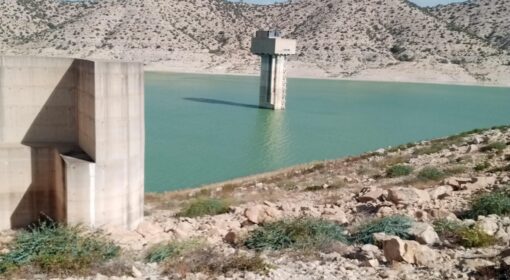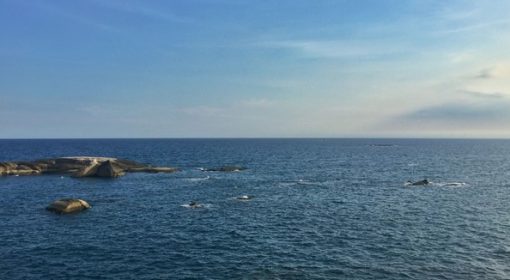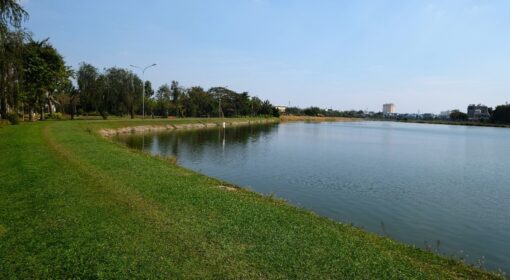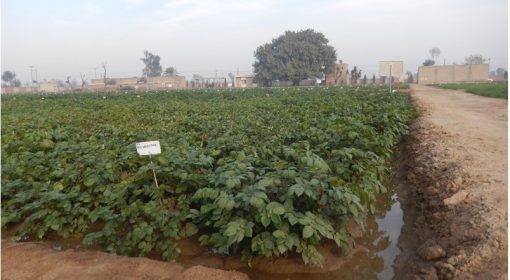By Frank van Steenbergen and Nadim Farajalla
August 18, 2021
Agriculture is the biggest user of water in Tunisia, consuming 80% of the available freshwater. Groundwater is an important source here, but it is severely overexploited – a pattern unfortunately common in the MENA Region. Its use was for decades approximately double the natural recharge: causing a decrease in groundwater levels as well as seawater intrusion in the coastal zone (El Ayni et al. 2012). Closely related to this, more and more relatively saline groundwater was used for irrigation, thereby increasing agricultural land salinity and reducing land productivity, which resulted in some land becoming entirely unfit for agricultural use (Gaaloul et al., 2003).
The Korba coastal plain is located in the east of the Cape Bon peninsula in north-eastern Tunisia. It is an area of around 40 km by 10 km, bounded by the Mediterranean Sea along the eastern border. The geology of the region (Pliocene-quaternary) mainly consists of sandstones, conglomerates and clay. The river network of Cape Bon consists of short watercourses. The climate is semi-arid with a 420 mm mean – yet annual precipitation has high variability. Due to the hot arid climate, average annual potential evapotranspiration is 1100 mm (El Ayni et al. 2011).
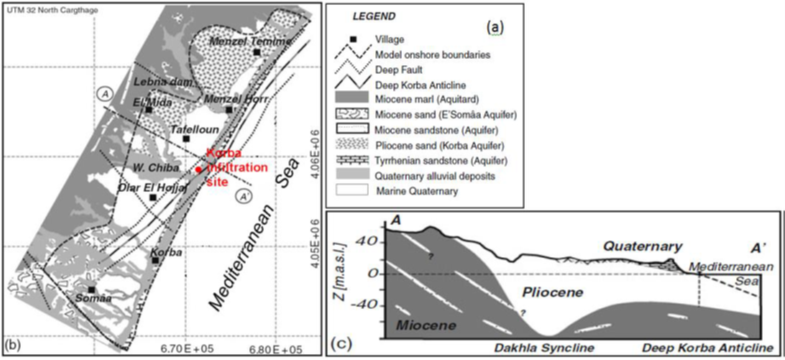
The Korba aquifer presents a fairly typical case of coastal groundwater depletion and seawater intrusion caused by the large quantities of water abstracted by the agricultural and industrial sectors from the 1960s onwards (Carry et al. 2013). Withdrawals were estimated to be approximately 50 Million m3/year during the last few decades. From the early 1980s more than 9,000 wells were pumping groundwater (DGRE, 2005). Aquifer recharge was highly variable in space and time and mainly occurred through infiltration of rainfall. The effective recharge was around 8 % to 30 % of the 420 mm/yr average annual rainfall. This amounts to 29 M m3/yr on average (Kerrou et al. 2010). The shortfall between replenishment and use led to seawater intrusion in the Korba aquifer, affecting groundwater as far as 2 km inland. Groundwater salinity reached 15000 ppm in some areas – half the level of seawater.
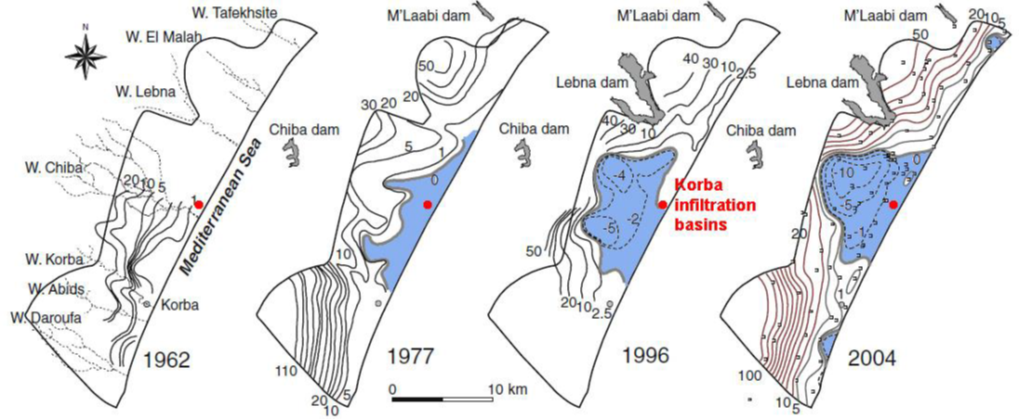
To close the deficit, plans for recharge with treated waste water were developed from 2002 onwards. Located 10 km north to the main city, the Korba plant was dimensioned for 7,500 m3 of wastewater per day, though it actually receives about 5,000 m3 per day. It is an urban plant that gathers domestic as well as waters provided by industries such as jean washing, fish, steel, slaughterhouse, and tomatoes factories. The flow variations of the Korba plant depend on winter rainfall and on seasonal fluctuations of the output from food industries. The treatment process consists of three successive steps: pre-treatment, secondary then tertiary treatments (El Ayni et al. 2011). The pre-treatment consists of the removal of large solid waste, followed by de-sanding and pool de-oiling processes. The secondary treatment allows the development of bacterial flocs, and is performed by an oxidation channel process. The tertiary treatment is performed by three natural surface ponds of maturations (Chaieb et al. 2013).
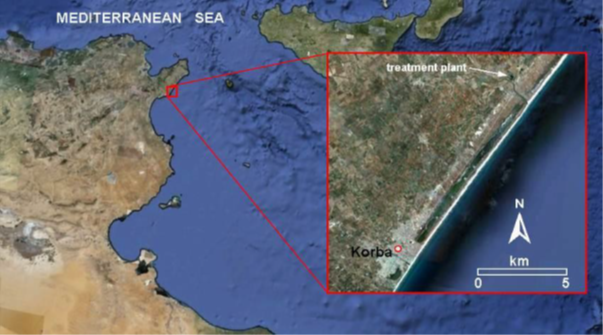
In 2008, the authorities moved towards integrated water resources management, in particular introducing managed aquifer recharge with treated wastewater in order to provide a hydraulic barrier against seawater intrusion. It was one of the first such attempts in Tunisia. The treated wastewater is infiltrated through ponds and undergoes soil aquifer treatment to improve its quality. The Korba artificial recharge site lies 15 m above sea level and contains three infiltration basins, of which two function simultaneously. The monthly volume of water injected into the basins has ranged from 6,000 m3 to 37,653 m3 with a total of about 1.15 Mm3 of injected treated wastewater between December 2008 and March 2012. (El Ayni et al., 2011).
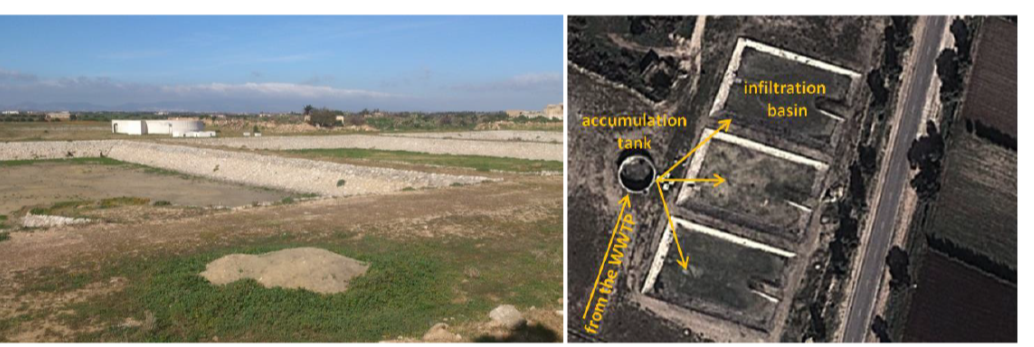
Implementation
In order to assess the impact of the recharge of the aquifer by treated waste water, salinity was analysed from groundwater before and after several years of recharge, as well as in treated waste water itself during this period of time.
Referring to the distribution of salinity prior to recharge, it is clear that the Northern and Southwestern part of the Cape is highly saline: the recorded concentrations exceed 2.5 g/L and reach 7.0 g/L in the extreme North (see figure 5). The South-eastern part shows a relatively good quality with salinity variying between 0.5 and 2.5 g/L. The initial quality of the aquifer regarding salinity was modest. In fact, more than 50% of ground water of the region is of poor quality in terms of salinity. These high levels of salts can be linked to several factors. The main reason is the progressive movement of saline seawater due to the increase in pumping; a second reason is the reduction of the recharge of the aquifer by rainfall or surface waters (Cherif et al. 2013). The high evaporation during irrigation with pumped water exacerbated by the high temperatures can also concentrate salt in the waters before it infiltrates into the aquifer.
The analysis of the treated waste water during the recharge period show salt concentrations ranging from 1.8 to 5.4 g/L. After the first years of aquifer recharge by treated waste water, changes in salinity levels occurred in almost all points close to the recharge plant. There is a clear lowering of groundwater salinity near the recharge site and in all of the South-eastern area. The area with lower salt concentrations (between 0.5 and 1.5 g/L) extended towards the North – out of reach of the infiltration basins.

Successes and challenges
The comparison of the quality of the groundwater before 2008 and after the first three years of recharge, resulting from the mixing of groundwater and infiltrated treated waste water, shows the contribution of this strategy to help mitigate saltwater intrusion in coastal aquifers (Cherif et al., 2013). It shows that non-conventional water resource can be mobilized for recharge and that discharge presents a safe disposal opportunity for treated waste water. Whatever positive contribution made, however, it could not close the huge gap between usage and replenishment, even though usage with the progression of salinity and the shock of overuse had declined. Another assessment was made six years into the operation of the recharge system, Results showed that artificial recharge, with a rate of 1500 m3/day – or one fifth of its original design capacity could produce a recovery in groundwater level by up to 2.7 m and a reduction in groundwater salinity by as much as 5.7 g/L over the period. All in all, the recovery of the Korba aquifer with the treated waste water helped but did not recover the entire system (Horriche et al, 2020).
References
- Cary, L., Casanova, J., Gaaloul, N., & Guerrot, C. (2013). Combining boron isotopes and carbamazepine to trace sewage in salinized groundwater: a case study in Cap Bon, Tunisia. Applied geochemistry, 34, 126-139.
- Chaieb, H., Moncef, R., Ouerfelli, N., Laghi, M., Magagnini, L., Tosatto, O., … & Teatini, P. (2013). On the effectiveness of reusing treated wastewater by infiltration ponds in coastal farmlands. Preliminary investigation on insights from the Korba site, Tunisia. In 1st CIGR Inter-Regional Conference on Land and Water Challenges, Paper (No. S7-8).
- Cherif S.,· El Ayni F., Jrad A., Trabelsi-Ayadi M., 2013. Aquifer recharge by treated tastewaters: Korba case study (Tunisia). Sustainable Sanitation Practice, Issue 14/2013.
- DGRE – Direction Générale des Resources en Eaux, 2005. Study from the Ministry for Agriculture and the Hydraulic Resources: Situation of groundwater exploitation. Ministry of Agriculture and Hydraulic Resources, Tunisia
- El Ayni F., Cherif S.,·Jrad A., Trabelsi-Ayadi M., 2011. Impact of treated wastewater reuse on agriculture and aquifer recharge in a coastal area: Korba case study. Water Resour Manage (2011) 25:2251–2265
- El Ayni F., Cherif S., Manoli E., Assimacopoulos D., Jrad A., Trabelsi-Ayadi M., 2012. Impact of agriculture on a Tunisian coastal aquifer and possible approaches for a better water management. In: Sixteenth International Water Technology Conference, IWTC 16 2012, Istanbul, Turkey.
- Gaaloul, N., Cheng, A.H.D. (2003) Hydrogeological and hydrochemical investigation of coastal aquifers in Tunisia-Crisis in overexploitation and salinization. In: Marin, L. (ed) Proceedings of the Second International Conference on Saltwater Intrusion and Coastal Aquifers-Monitoring, Modeling and Management, 30 March – 2 April 2003, Merida, Mexico.
- Horriche, Faten Jarraya and Sihem Benabdallah (2020) Assessing Aquifer Water Level and Salinity for a Managed Artificial Recharge Site Using Reclaimed Water. In: Water 2020, 12(2), 341 https://doi.org/10.3390/w12020341
- Kerrou, J., Renard, P., Tarhouni, J. (2010): Status of the Korba groundwater resources (Tunisia): observations and threedimensional modelling of seawater intrusion. Hydrogeol. 18 (5), 1173–1190.
Prepared in support of the development of Voluntary Guidelines for Sustainable Water Allocation in Agriculture by FAO, ESCWA and AOAD for the League of Arab States
